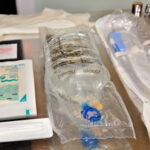Septic hip, also known as septic arthritis, or infectious arthritis is an infection of the hip joint, and it is not very common; however anyone can develop the infection, though it is most common in children under the age of 3. In children, septic hip can develop a bacterial infection, or suffered trauma to the hip. Some children have no symptoms in the beginning of the illness.
Septic hip less common in adults, although it is fairly common in people with suppressed immune systems. This form of sepsis can form in any joint; in other joints it is called septic arthritis, or infectious arthritis. For the sake of this article I will focus on the septic hip.
Adults most at risk to developing septic hip are those who have rheumatoid arthritis, have had an artificial hip implant, are being treated with immunosuppressant drugs, have had arthroscopic surgery, or any surgery on the hip. Adults and children with sickle cell disease are also at risk, and those who suffer from a weakened immune system due to chronic illness.
Symptoms
In newborns and infants:
Fever
Pseudoparalysis (unable to move the infected hip and leg)
Pain (cries whenever the hip joint is moved)
Irritability
In children and adults:
Low grade fever
Redness in the area of the hip
Severe Hip pain
Inability to move the hip
Though it is relatively rare in adults, if you injured your hip, or have had hip surgery and after months you are suffering severe pain, and have an elevated temperature you could be developing a septic hip. You might also complain with both hip and back pain. The pain may progress over time to be unbearable. You might also experience pain in your groin area. Walking may become difficult as you limp and favor the hip. Sometimes people ignore the pain, and think it will go away in time. Unfortunately they wait too long and may have to end up having a total hip replacement.
Not everyone has similar symptoms. You might not run an elevated temperature , or you might not be aware of it if you do have a low grade fever. You might not even present with severe pain right away. In adults, the person could have a septic hip for as long as a year and not even be aware of it, because the symptoms can mimic rheumatoid or osteoarthritis.
As a nurse, working in orthopedics, I have cared for patients that had to undergo total hip replacement surgery due to the damage done by septic hip. It could be that they ignored the pain, or were misdiagnosed when all the symptoms of septic hip wasn’t present. The symptoms of septic hip may not be evident n the beginning; it can look a lot like degenerative joint disease, and it may not be diagnosed right away.
The diagnosis
Whether the patient is an adult, child, or infant the physician will conduct an examination to locate the source of the problem. If the patient is complaining of severe pain and cannot move the hip, and the patient has a low grade temperature the doctor may suspect septic hip. Because of the elevated temperature, the doctor would suspect infection, so lab work would be drawn to check for the presence of pathogenic organisms.
X-rays will be taken of the hip to evaluate the structure and placement of the hip in comparison to the surrounding bones. The doctor may also order an ultrasound, and an MRI to check for the presence of excess fluid accumulating around the joint.
If an infection is suspected, the doctor will insert a needle into the hip joint and aspirate some of the synovial fluid from around the joint. If the fluid is purulent (has pus in it), a sample will be collected for a culture and sensitivity to identify the organism, and determine the antibiotic that will kill it.
Treatment
If there is no purulence in the synovial fluid within the hip, septic hip should be able to be treated with antibiotic therapy and immobilization; however, surgery is indicated when there is evidence of pus in the synovial fluid. Without surgery the hip joint, with its connective tissues and cartilage could suffer permanent damage.
If the patient is a child, diagnosis and treatment will have to be swift, because the joint is still growing. Damage to the inner structures of the joint in a growing child could destroy the joint permanently. If the infection is caught before any purulence is noted in the synovial fluid, the child may be treated with antibiotic therapy, immobilization of the hip joint, and warm compresses for discomfort.
Soon after treatment the doctor may order physical therapy. At first while the hip is still sore the therapist will perform passive range of motion, and as you gain more mobility you may be working with the therapist to regain full motion of the hip.
Prognosis
If the infection is caught early the prognosis is very good for recovery; however, if the diagnosis and treatment is not done swiftly permanent damage to the hip may result.
Sources:
http://www.eorthopod.com/public/patient_education/6631/septic_arthritis_of_the_hip_in_children.html
http://www.jabfm.org/cgi/content/full/20/3/307



